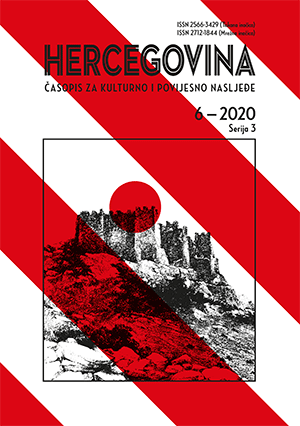Stećci na području Dubrovačkoga primorja - nove spoznaje
Stecaks in Dubrovnik Littoral - new findings
Author(s): Domagoj PerkićSubject(s): Cultural history, Local History / Microhistory, Middle Ages
Published by: Filozofski fakultet Sveučilišta u Mostaru - Studij povijesti i Hrvatski institut za povijest - Zagreb
Keywords: stecaks; Dubrovnik Littoral; Cepikuce; Novakovo Greblje; topography; archaeological excavation; conservation;
Summary/Abstract: Detailed survey of stecak sites in wider Dubrovnik re¬gion was published in the context of creating the catalogue for the exhibition "Stecaks" held in Klovicevi Dvori in Zagreb (2008) and later in the framework of the project "HER.CUL" (2010-2013) as well as in the publication of Dubrovnik Museums: Stecaks and other late medieval gravestones in the western Dubrovnik region (2018-2019). In this way the status of at least topographic and statistic data was updated. In that context, we can find stecaks in the area of Konavle Municipality (24 sites with 588 stecaks), Municipality of Zupa Dubrovacka (4 sites with 21 stecaks) administrative area of the City of Dubrovnik from Sumet in the east to Dubravica and Ridica in the West (10 sites with 68 stecaks) and Dubrovnik coastal area (29 sites with 362 stecaks). That would be 67 sites with 1039 stecaks in total. Archaeological research as well as conservation and restoration of all stecaks at the site Novakovo Greblje in Cepikuce, Dubrov¬nik Littoral Municipality are also published in the framework of the mentioned project "HER.CUL". Archaeological excavations from 2013 showed that late medieval graveyard with stecaks was located at the position of the former graveyard from the 8th/9th century AD. Cluster of bones (of at least 10 individuals) was the only leftover from the former graveyard and it was located in the central part of the site. As far as the graveyard with stecaks is concerned there were 6 stecaks and 5 graves with 15 buried individuals in total. According to the results of C-14 analysis graveyard was used from the first half of the 13th century to the second half of the 15th century. Only one woman was buried in the period from 1300 to 1400 under the biggest and most beautiful stecak, gabled tombstone, decorated by the shield and sworn and illustration of a horseman. That is a very valuable information for us, because we can place the emergence of the gabled tombstone in that period. Question of possible continuation of burying under stecaks after Dubrovnik Littoral became a part of Dubrovnik Republic in 1399, is also solved. It was determined that at least two burials had been performed in the 15th century. Although Novakovo Greblje is for the time being the only systematically archaeologically researched graveyard with stecaks in Dubrovnik region, it can be assumed that burying under stecaks was continued independently of changes in the government and ruling with certain areas. In any case, those are extremely valuable remnants of the late Middle Ages cultural heritage, which complete knowledge of stecaks culture, not only in Dubrovnik but also wider region.
Journal: Hercegovina. Časopis za kulturno i povijesno naslijeđe (od 2018)
- Issue Year: 2020
- Issue No: 6
- Page Range: 19-61
- Page Count: 43
- Language: Croatian

